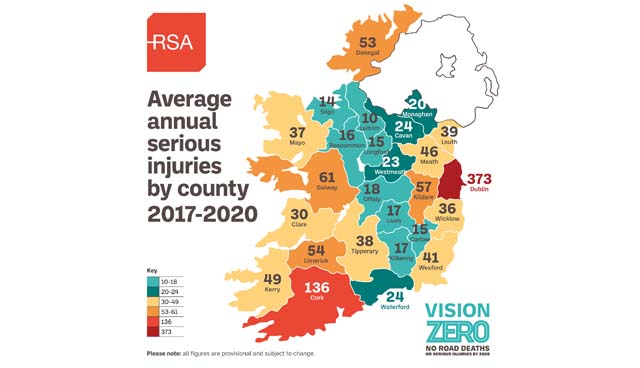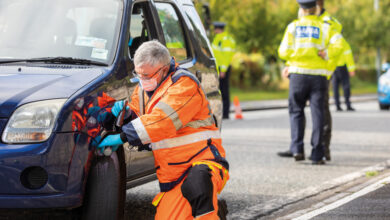Serious injuries on Irish roads, 2017-2020

For each death on Irish roads over a four-year period from 2017 to 2020, there were almost nine serious injuries. Velma Burns, Head of Research with the Road Safety Authority (RSA) speaks with eolas about understanding the nature of the problem and key policy measures to address it in the context of the new government Road Safety Strategy for the next decade.
Mirroring its ambitious target for fatalities, Our Journey Towards Vision Zero, the Government’s latest road safety strategy for the period between 2021 and 2030, has a target of reducing serious injuries by 50 per cent.
“The new Road Safety Strategy puts fatalities and serious injuries on an equal footing in terms of ambition,” Burns explains.
Definition
A serious injury is defined as being an injury which results in a person being admitted to hospital as an in-patient or injuries such as fracture; concussion; internal injury; crushing; severe cuts or laceration; or severe general shock, whether or not they require hospital admission.
While gardaí apply this definition when they are tasked with responding to a collision, it is acknowledged that they are not medics, and this poses a challenge at the roadside. To compliment this, therefore, the RSA research department implements quality control procedures to ensure optimal application of the definition, post-data collection.
Long-term trend
Between 1998 and 2012, there was a steady decline in the number of serious injuries reported on Irish roads. Thereafter, there was a steady increase in serious injuries up to 2019 when serious injuries peaked at 1,484.
“It is important to point out that in 2014 there was a break in time series for this data. This reflects a change in the mechanism for recording road traffic collisions, as well as a change in the mechanisms whereby the RSA receives collision data from An Garda Síochána,” the Head of Research says.
“We now have access to very good electronic data download on an almost daily basis from An Garda Síochána, alongside enhanced validation and quality control procedures. This new mechanism is providing the RSA with a more complete picture of the number of serious injuries on Irish roads.”
While it is internationally acknowledged that serious injuries can be underreported in police data, the RSA believes that this change in methodology is improving the data the RSA receives.
Meanwhile, serious injury numbers declined in both 2020 and 2021, coinciding with the Covid-19 pandemic. “We believe that the drop in traffic volumes observed during the pandemic is a factor contributing to the reduction in serious injuries on our roads,” Burns remarks.
European comparison
Typically, for fatality data, the RSA reports per million of the population which enables performance comparisons with European counterparts. However, there are some challenges in undertaking a similar comparison for serious injuries.
Primarily, there are different serious injury definitions in operation across Europe, hampering the ability to compare rates. To counteract this, there has been a move to compliment collision data with hospital data. The subsequent definition suggested by the European Commission is the Maximum Abbreviated Injury Scale (MAIS3+). This is an extrapolation of the International Classification of Diseases (ICD) system which is used within hospitals.
In Ireland, the first phase of work in translating Hospital In-Patient Enquiry (HIPE) data to MAIS3+ was completed as a pilot project in 2016. Over the coming decade, the new strategy will ensure increased focus on serious injuries. The RSA is planning a second phase of work with HIPE data which will commence in Q3 2022.
Who is being seriously injured on our roads?
There are several high-level trends apparent in serious injury data for the years from 2017 to 2020.
Mode of transport
Drivers accounted for a plurality (32 per cent) of serious injuries over a four-year period from 2017 to 2020, followed by pedestrians (21 per cent), and cyclists (20 per cent). Overall, vulnerable road users (cyclists, pedestrians, and motorcyclists) account for over half (54 per cent) of all serious injuries.
The figures for the annual average serious injuries and fatalities by road user group from 2017 to 2020 show that for every one driver killed on Irish roads, there are six drivers sustaining serious injuries each year. “I would like to point out cyclists in particular because the ratio is stark; for every one cyclist killed, there are 25 cyclists seriously injured,” Burns highlights.
Gender
RSA data indicates that with the exception of motor vehicle passengers, all road user groups exhibited higher proportions of seriously injured males. This is particularly true for motorcyclists and for pedal cyclists, where men accounted for 94 per cent and 77 per cent of those seriously injured, respectively.
Age
For serious injuries, 35 per cent of those seriously injured are in the 26 to 45 age category and 25 per cent are in the 46 to 65 cohort. This is broadly similar with the figures for fatalities with 31 per cent of those killed in the 26 to 45 category and 27 per cent in the 46 to 65 cohort.
Counties
Over the last four years, the greatest number of average annual serious injuries – 373 – occurred in Dublin, followed by Cork and Galway which had average annual serious injuries totalling 136 and 61 respectively.
Where are these serious injuries occurring?
Three-quarters of driver (75 per cent) and passenger (73 per cent) serious injuries are occurring on higher speed rural roads. However, the picture is very different when considering vulnerable road users, particularly cyclists and pedestrians. At least four-fifths of cyclist (81 per cent) and pedestrian (86 per cent) serious injuries are occurring on urban roads.
When are these serious injuries occurring?
There is a very consistent picture of serious injury across the days of the week, with between 14 and 15 per cent occurring each day.
Policy
What then are the policy measures to address the problem of serious injuries on Irish roads?
The new government Road Safety Strategy for the next decade, Our Journey Towards Vision Zero, incorporates a Phase 1 action plan for 2021 to 2024 containing 50 high-impact actions which the RSA believes will make the greatest contribution to achieving the ambitious targets of 50 per cent reductions in fatalities and serious injuries.
“We have also identified 136 support actions which will be instrumental in helping us to achieve these ambitions,” Burns notes, adding: “These are grouped across seven priority intervention areas, broadly aligning with the Safe System Approach, the objective of which is strengthening the system to prevent death and serious injury on our roads.”
1. Safe roads and roadsides: Actions include developing 1,000km of segregated active travel infrastructure, as well as increasing the length of the divided road network.
2. Safe speeds: Actions include reviewing the framework for speed limits, including a default speed limit of 30km/h for urban areas, and expanding speed management measures.
3. Safe vehicles: Actions include prioritising in-vehicle safety assist features and developing a national strategy for Connected and Automated Mobility.
4. Safe road use: Actions include penalties for serious road traffic offences and legislating for polydrug, drug, and alcohol use.
5. Post-crash response: Actions include implementing a trauma triage and bypass protocol, as well as providing trauma care and rehabilitation pathways.
6. Safe and healthy modes of transport: Actions include funding active travel infrastructure and developing a National Cycle Network Plan.
7. Safe work-related road use: Actions include improving data sharing to support enforcement, policy development and evaluation, as well as encouraging businesses to sign up to the European Road Safety Charter.
Next steps
Summarising, Burns outlines the immediate steps the RSA will now take, including the publication of spotlight reports on trends in serious injuries by road user group, helping to inform evidence-based intervention.
“The RSA will also be initiating collaboration with the HSE and Trinity College Dublin on the reporting of serious injuries using MAIS3+ hospital data. We will also cooperate with our partners and road safety stakeholders to implement the Road Safety Strategy’s Phase 1 actions,” she concludes.
T: 096 25000
E: info@rsa.ie
W: www.rsa.ie






